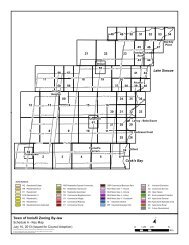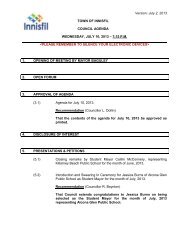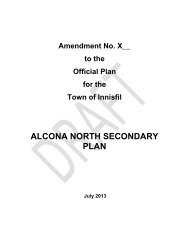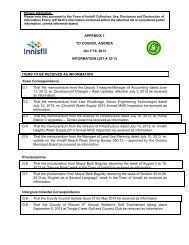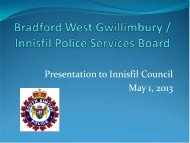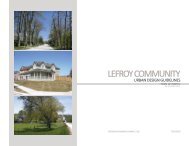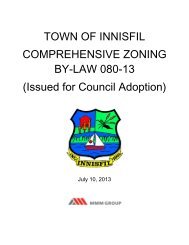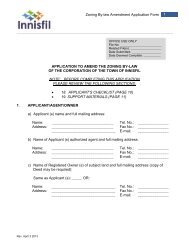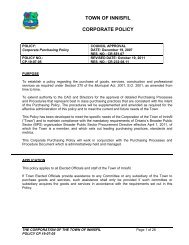Innisfil Official Plan OMB Approved - Town of Innisfil
Innisfil Official Plan OMB Approved - Town of Innisfil
Innisfil Official Plan OMB Approved - Town of Innisfil
Create successful ePaper yourself
Turn your PDF publications into a flip-book with our unique Google optimized e-Paper software.
<strong>Town</strong> <strong>of</strong> <strong>Innisfil</strong> <strong>Official</strong> <strong>Plan</strong>IMPLEMENTATION9. 20.20 Flooding hazard: means the inundation, under the conditions specified below, <strong>of</strong>areas adjacent to a shoreline or a river or stream system and not ordinarily covered bywater:a) Along the shorelines <strong>of</strong> the Great Lakes - St. Lawrence River System and largeinland lakes, the flooding hazard limit is based on the one hundred year flood levelplus an allowance for wave uprush and other water-related hazards;b) Along river, stream and small inland lake systems, the flooding hazard limit is thegreater <strong>of</strong>:1. the flood resulting from the rainfall actually experienced during a major stormsuch as the Hurricane Hazel storm (1954) or the Timmins storm (1961),transposed over a specific watershed and combined with the local conditions,where evidence suggests that the storm event could have potentially occurredover watersheds in the general area;2. the one hundred year flood; and3. a flood which is greater than 1 or 2, and which was actually experienced in aparticular watershed or portion there<strong>of</strong> as a result <strong>of</strong> ice jams and which hasbeen approved as the standard for that specific area by the Minister <strong>of</strong> NaturalResources; except where the use <strong>of</strong> the one hundred year flood or the actuallyexperienced event has been approved by the Minister <strong>of</strong> Natural Resourcesas the standard for a specific watershed (where the past history <strong>of</strong> floodingsupports the lowering <strong>of</strong> the standard).9.20.21 Floodpro<strong>of</strong>ing standard: means the combination <strong>of</strong> measures incorporated into thebasic design and/or construction <strong>of</strong> buildings, structures, or properties to reduce oreliminate flooding hazards, wave uprush and other water-related hazards along theshorelines <strong>of</strong> the Great Lakes - St. Lawrence River System and large inland lakes, andflooding hazards along river, stream and small inland lake systems.9.20.22 Floodway: for river, stream and small inland lake systems, means the portion <strong>of</strong> theflood plain where development and site alteration would cause a danger to publichealth and safety or property damage. Where the one zone concept is applied, thefloodway is the entire contiguous flood plain. Where the two zone concept is applied,the floodway is the contiguous inner portion <strong>of</strong> the flood plain, representing that arearequired for the safe passage <strong>of</strong> flood flow and/or that area where flood depths and/orvelocities are considered to be such that they pose a potential threat to life and/orproperty damage. Where the two zone concept applies, the outer portion <strong>of</strong> the floodplain is called the flood fringe.9.20.23 G1, G2, G3, S1, S2, or S3 plant or animal species, or community: the NaturalHeritage Information Centre (MNR) assigns a rarity ranking <strong>of</strong> 1 to 5 to species <strong>of</strong>plants, animals and communities in Ontario. Provincial status (e.g. provincially rarespecies) are known as "S-ranks", and global rankings as "G-ranks". For the purpose <strong>of</strong>this document, rankings <strong>of</strong> 1, 2 or 3 are considered rare.G1: Extremely rare; usually 5 or fewer occurrences in the overall range or very fewremaining individuals; or because <strong>of</strong> some factor(s) making it especially vulnerable toextinction.136Adopted July 26, 2006 <strong>Approved</strong> by <strong>OMB</strong> May 2009, March 2010 & April 8, 2011





